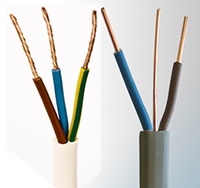
This article describes the main characteristics of most of the different types of cable that is currently used in domestic installations and that we use on a daily basis.
The following have their own articles:
The difference between Flex and Cable
 Flex is stranded electrical wire commonly used for all types of plug-in mains appliance leads. It is also called flexible cable.
Flex is stranded electrical wire commonly used for all types of plug-in mains appliance leads. It is also called flexible cable.
Cable on the other hand is unstranded solid cored wire not suited to repeated flexing and so is used for fixed installations.
Note, that with flex each cable is has its own sheath in the respective colours while the cable has only the live and neutral covered. When you are going to use the cable you also have to remember to put on a little earth sleeving to protect the earth and keep it seperate.
Earth Sleeving

Earth sleeving is a plastic non conductive tube that comes in a variety of diameters, 2 to 6 mm, to fit all types of cables, and is designed to fit over the bare earth conductor that comes with most types of cable.
New & Old Colour Combinations
 Current colours:
Current colours:
L – brown
N – blue
E – green/yellow striped
Old colours: (until about 1970)Â
L – red
N – black
E – green
2 Core Flexes
 Flexes are available with 2 or 3 cores (conductors). 2 core flex is only suitable for appliances that don’t need an earth connection (marked), and should not be used for extension leads with 3 pin sockets or plugs.
Flexes are available with 2 or 3 cores (conductors). 2 core flex is only suitable for appliances that don’t need an earth connection (marked), and should not be used for extension leads with 3 pin sockets or plugs.
2 core flexes are available in both round and oval shape. Oval (flat) uses less material, but any twisting of the flex is visible, whereas it isn’t with round.
4 core Flexes
Multicore mains flexes are also available for those uncommon tasks requiring more conductors. Non-mains multicores, such as alarm cable, are not suitable for mains use.
Insulation
PVC
Novelty PVC flexes
Most flex has PVC insulation rated to 70°C.
90°C PVC is also available for use in hot locations, such as for immersion heaters. A higher temp rating means a given conductor size can carry more current.
Arctic

Arctic flex remains flexible at low temperatures, whereas regular PVC stiffens. Arctic flex is used for outoor appliances, eg on building sites.
It is rated for use down to -40°C.
Available in Blue for 220V applications and Yellow for 110V applications
Rubber
TRS (tough rubber sheath) is a flex with greater mechanical strength and damage resistance than PVC. It is used when some degree of rough use can be expected.
Cloth flex
Flexes with a cloth outer have rubber  inner insulation. These have a high temperature rated outer surface. They are well known for their use on irons.
inner insulation. These have a high temperature rated outer surface. They are well known for their use on irons.
Old cloth insulated flexes are prone to kinking, with the inner rubber insulated wires poking out at the kinks. New cloth insulated flexes have a layer of rubber under the cloth that discourages this from happening and now coming in a myriad of colours to go with old style and antique lights etc to give them a fresh lease of life.
The rubber inner insulation can harden and break at the ends. This is often seen on old cloth flexes. When this occurs the flex can be cut back several inches to reveal healthy flex, and reconnected, if the rest of the flex is still healthy.
Figure of 8
 Figure of 8 shaped plastic flex was formerly used for low current mains uses. It has a single layer of insulation only, and live conductors are easily exposed by minor damage. It was used in several colours, including black, brown, white and clear.
Figure of 8 shaped plastic flex was formerly used for low current mains uses. It has a single layer of insulation only, and live conductors are easily exposed by minor damage. It was used in several colours, including black, brown, white and clear.
Such flex has been unlawful to fit to mains appliances for decades, but is still occasionally seen in use. Today this flex type is used as speaker wire.
Twisted Pair
2 core cloth & rubber (VIR) twisted mains flex with no outer sheath was once in common use. Most were dark red or brown. This flex has been obsolete for decades, and is rarely seen today. Occasionally its seen on historic electrical goods, and when found is usually in a dangerous condition. Apart from not meeting modern safety requirements it can be so fragile that when bent the old flex or cable it will perish and disintegrate in your hand exposing bare live wires. Despite once being in widespread use, it is rarely seen today because it deteriorates so badly over time.